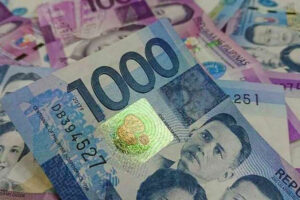Peso may trade at P54-P57 this year on monetary easing bets

THE PESO is seen moving within the P54 to P57 level against the dollar this year amid expectations of monetary policy easing at home and in the United States, and with markets watching oil prices to anticipate inflation trends.
The local currency closed at P55.37 versus the dollar on Friday, appreciating by 11 centavos from Thursday’s P55.48 finish, data from the Bankers Association of the Philippines’ website showed.
Dec. 29 was the last trading day for 2023. For the year, the peso appreciated by 38.5 centavos or 0.7% from its P55.755-per-dollar close at end-2022.
Meanwhile, week on week, the peso gained three centavos from its P55.40 close on Dec. 22.
The peso appreciated against the dollar this year amid the decline in global crude oil prices, Rizal Commercial Banking Corp. Chief Economist Michael L. Ricafort said in a Viber message.
Easing crude prices could reduce the country’s oil import bill and narrow the country’s trade deficit, as well as help bring down inflation towards the Bangko Sentral ng Pilipinas’ (BSP) 2-4% target, Mr. Ricafort said.
For this year, the peso could trade between P54 and P57 versus the dollar, with oil price movements and their effect on inflation to be a main trading driver, he said.
The US Federal Reserve and the BSP’s possible rate cuts this year amid expectations of slowing inflation will also affect foreign exchange trading, he added.
BSP Governor Eli M. Remolona, Jr. last month said the central bank is unlikely to deliver any benchmark interest rate cuts in the next few months and is leaning towards keeping borrowing costs higher for longer.
The BSP will only begin policy easing if inflation settles within a “comfortable” range or the midpoint of its 2-4% target band, Mr. Remolona said.
The central bank raised borrowing costs by a total of 450 bps from May 2022 to October 2023, bringing the policy rate to a 16-year high of 6.5%.
Meanwhile, the US central bank last month kept borrowing costs unchanged at 5.25-5.5% for the third straight time. This was after it hiked policy rates by 525 bps from March 2022 to July 2023.
Markets expect the Fed to begin easing its policy stance as early as March, with investors penciling in cuts worth up to 150 bps this year.
“Despite persistence of current account deficits, more peso strength can be seen in 2024 as global easing cycles typically underpin EM (emerging markets) currency gains,” Bank of the Philippine Islands Lead Economist Emilio S. Neri, Jr. said in a Viber message.
The BSP will likely “cap the peso’s appreciation” and keep it at the P54 level as the difference between the Fed and the BSP’s key rates begin to widen, Mr. Neri added.
Still, the peso could climb to the P53 level if the Fed cuts earlier and by bigger increments than market expectations, Mr. Neri added.
For this week, Mr. Ricafort said the peso could trade between P55.20 and P55.70 per dollar. — AMCS




